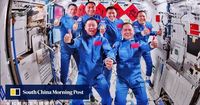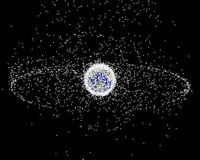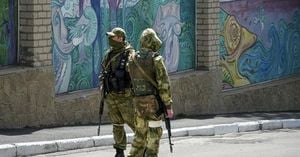On November 5, 2025, China’s ambitious space program encountered an unexpected setback when the return of three astronauts from the Tiangong space station was postponed due to a suspected collision with space debris. The delay, which affects the crew of the Shenzhou-20 mission, highlights the growing risks posed by the proliferation of orbital junk and underscores the challenges faced by nations vying for leadership in human spaceflight.
The China Manned Space Agency (CMSA) announced on Wednesday that the Shenzhou-20 spacecraft, which was scheduled to return its crew to Earth, was suspected of being struck by a tiny piece of space debris. “The Shenzhou-20 manned spacecraft is suspected of being hit by a tiny piece of space debris, and an impact analysis and risk assessment are under way,” the CMSA stated, according to AFP. The agency emphasized that the return, originally planned for Wednesday, November 5, would be postponed to ensure the safety and health of the astronauts. No new return date has been set, leaving the fate of the crew in temporary limbo.
The three astronauts—mission commander Chen Dong, fighter pilot Chen Zhongrui, and engineer Wang Jie—have been aboard the Tiangong space station since April 2025, completing a six-month rotation. Their journey began at the Jiuquan Satellite Launch Center in the Gobi Desert, and they were expected to touch down at the Dongfeng Landing Site in northern Inner Mongolia. Instead, their homecoming has been put on hold as experts analyze whether the debris strike caused damage to critical spacecraft systems that could jeopardize re-entry.
The timing of the incident is particularly notable. Just days earlier, their replacements arrived at Tiangong aboard the Shenzhou-21 spacecraft, successfully docking on Saturday, November 1. The two crews participated in a ceremonial handover, with Chen Dong formally passing over operational responsibilities. “We are about to return to Earth, and now I am handing over the hatch key that symbolizes the right to maintain operations on this Chinese space station to you,” Chen Dong said during the event, as reported by Chinese state media. The moment, meant to mark a smooth transition, has now become a pause in China’s otherwise meticulously choreographed space program.
The Shenzhou program, which routinely sends trios of astronauts for six-month stays aboard Tiangong, is a source of immense national pride. The Tiangong station—whose name means “Heavenly Palace”—has become the crown jewel of China’s space ambitions. Billions of dollars have been invested to catch up with the United States and Russia, and the country is now aiming to send a crewed mission to the moon by 2030, with even grander plans to establish a lunar base in the future, according to AFP and The New York Times.
This is not the first time that a return mission has faced delays, but it is the first instance where space debris has been the cause. Earlier this year, the Shenzhou-19 crew’s return was postponed by a day due to adverse weather conditions. The current situation, however, underscores the growing menace of space junk—discarded rocket stages, fragments from satellite collisions, and remnants of antisatellite weapon tests—that now orbits hundreds of miles above Earth. The CMSA has not specified whether Shenzhou-20 was struck while in flight or while docked, but both Shenzhou-20 and Shenzhou-21 are currently attached to Tiangong, with the crews in a handover period.
Protocols exist for such emergencies. If Shenzhou-20 is deemed unfit for re-entry after the ongoing risk assessment, the crew could return aboard Shenzhou-21. In the unlikely event that both vessels are compromised, a backup Shenzhou spacecraft and Long March-2F rocket—always on standby at the Jiuquan Satellite Launch Center—could be dispatched for a rescue. China’s space agency addressed such scenarios last year, noting that it could launch an unmanned emergency spacecraft to retrieve astronauts if necessary, The New York Times reported.
The proliferation of space debris is not a uniquely Chinese problem. According to Christophe Bonnal of the International Academy of Astronautics, “You don’t see them, and they are deadly.” Even objects as small as one millimeter can cause catastrophic damage, with impacts akin to a bowling ball hurtling at 100 kilometers per hour. Estimates suggest there are about 130 million such objects orbiting Earth, and the risk of collisions has risen with the deployment of massive satellite constellations like SpaceX’s Starlink and China’s own Qianfan and Guowang.
China has invested in technologies to mitigate these risks, including deorbiting sails that can speed up the descent of defunct spacecraft, ensuring they burn up in the atmosphere rather than contribute to the growing cloud of space junk. At a forum last year, President Xi Jinping called for international cooperation on space debris monitoring, proposing a joint “space debris observation center” with Arab nations. The United Nations, too, has urged the creation of a shared database and global tracking framework for orbital objects.
The issue of space debris is also a flashpoint in international relations. In 2021, China complained to the U.N. after Tiangong had to perform two emergency maneuvers to avoid fragments from Starlink satellites, owned by Elon Musk’s SpaceX. Beijing and Washington have traded accusations over debris-generating activities, with China pointing to the United States’ history of antisatellite tests and the U.S. condemning a 2007 Chinese missile test that created a massive debris field.
Meanwhile, the Shenzhou-20 crew’s extended mission offers a glimpse into the daily realities of life aboard Tiangong. During their six months in orbit, the astronauts have conducted spacewalks, handled cargo deliveries, and carried out scientific experiments. Both crews were recently seen sharing “barbecued” chicken wings in a lighthearted video broadcast by state media, a reminder of the camaraderie and resilience required to endure the rigors of space.
China’s progress in human spaceflight has been remarkable. After launching its first satellite in 1970, the country lagged behind for decades but has since surged to a close second behind the United States, according to space expert Jonathan McDowell. “They have now moved to this era of permanent human occupation,” McDowell told The New York Times. “That is a really impressive achievement from a late starter.”
Yet, the current predicament serves as a sobering reminder that the final frontier is fraught with hazards, both natural and man-made. The United States has faced similar challenges: last year, NASA astronauts Suni Williams and Butch Wilmore endured a nine-month stay on the International Space Station after their Boeing Starliner return craft malfunctioned, eventually returning home aboard a SpaceX Crew Dragon.
As the world’s space powers push the boundaries of exploration, the skies above grow ever more crowded and dangerous. The Shenzhou-20 incident may be resolved in days or weeks, but it will not be the last brush with orbital debris for China—or any nation. For now, Chen Dong, Chen Zhongrui, and Wang Jie remain in orbit, their safe return a matter of careful engineering, international vigilance, and perhaps a little luck.






